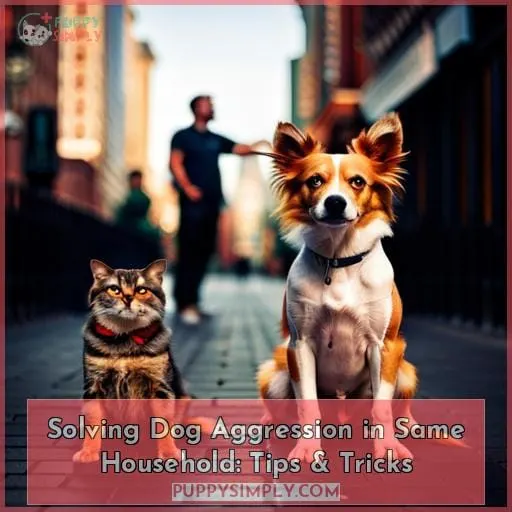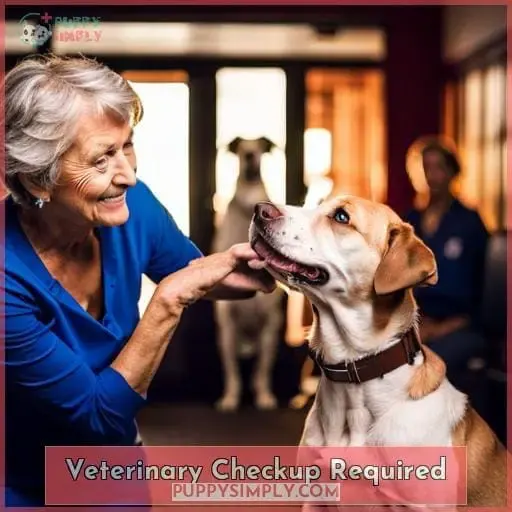This site is supported by our readers. We may earn a commission, at no cost to you, if you purchase through links.
It’s a heartbreaking sight to see: two family dogs locked in combat, snarling and snapping at each other. Dog aggression is a serious problem that can cause physical harm and emotional distress for all involved.
In this article, we will discuss why dogs fight in the first place as well as how owners can stop aggressive behaviors from taking root while keeping their furry friends safe. With patience and understanding, families with multiple pooches can learn how to live harmoniously together again without fear or anxiety looming over them every day.
Table Of Contents
- Key Takeaways
- Why Do Dogs Fight?
- Common Stressors for Dogs
- How Do You Stop Two Family Dogs From Fighting?
- Can Two Dogs Live Together After Fighting?
- How to Stop Dogs From Fighting
- More Management Tools
- Veterinary Checkup Required
- Last Resorts for Training Aggressive Dogs
- Take Responsibility for Your Dogs
- Frequently Asked Questions (FAQs)
- Conclusion
Key Takeaways

- Lack of socialization training and exercise can contribute to interdog aggression.
- Properly introducing new animals into a home can reduce fights due to territorial issues.
- Canine body language can indicate tension and potential fights between dogs.
- Calming aids and separate areas can be used to manage aggression.
Why Do Dogs Fight?
Understanding why your pets might be fighting can help you repair their trust and create a safer environment, so it’s important to know the signs of tension and unhappiness between them.
Interdog aggression cases are usually caused by one or more underlying factors, such as a lack of socialization training or an exercise regimen. Positive reinforcement techniques should always be used when trying to build relationships between dogs.
Properly introducing new animals into an existing home is also beneficial for all parties involved as it helps reduce any potential fights that may arise due to territorial issues like scent marking and threshold distance invasions.
It’s important for owners to understand canine body language in order to recognize if there is tension brewing between two dogs before things get out of hand. This includes observing subtle signals like raised hackles, lip-licking, or yawning, which could indicate fear or anxiety in either dog leading up to a fight breaking out.
If these behaviors are observed early on, then steps can be taken immediately, such as providing calming aids (e.g., essential oils), while implementing positive reinforcement methods with each animal separately from one another until they have built enough trust together where they will no longer need separate areas within the house anymore.
But don’t forget that some interdog aggression cases require further assistance from experts who specialize in behavioral modification therapy using medication alongside traditional behavior modification tactics (elements found within cc&d).
By recognizing how different dogs interact with each other, you’ll gain insight into what’s really going on beneath the surface when your furry family members spend time together. Investing time into learning about body language will allow you to make better decisions about living arrangements based upon individual personalities, rather than assuming every dog has the same characteristics, which would ultimately lead towards future disputes amongst themselves down the road, regardless of whether these dogs were once best friends prior.
Common Stressors for Dogs
Do you have multiple dogs in your household that seem to be fighting more than usual? Dogs may become aggressive due to a variety of stressors, such as food aggression or other triggers. It’s important for owners to understand these common sources of tension and take steps towards addressing the issues before they escalate further.
By recognizing how different dogs interact with each other, you can gain insight into what’s really going on beneath the surface when your furry family members spend time together.
Food Aggression
Seeing your beloved pets baring their teeth and snarling at each other over food can be an alarming sight, but it doesn’t have to mean the end of your furry family’s harmony. Food aggression in dogs is a common stressor that can be managed with patience and understanding.
Providing rewards, mental stimulation, positive reinforcement techniques, and establishing boundaries are key components for helping reduce aggressive behaviors towards food or one another.
Structured environments such as crating when feeding or enforcing a bite threshold with appropriate corrections through verbal cues may also help prevent future fights from happening again.
- Understand body language: Identifying tension before it escalates into physical contact helps avoid fights altogether by providing structure around mealtime rituals like eating separately on opposite sides of the room (if possible).
- Avoid Aversive Training Methods: Punishing communication only leads to further escalation, which could result in biting out of desperation – so steer clear from using controversial training methods like dominance theory here too!
- Medication Assistance: In severe cases where two animals simply cannot get along after trying multiple corrective strategies already mentioned above – medication may provide some assistance while working on behavior modification therapy alongside traditional tactics found within cc&d (consulting canine professionals).
- Rehoming Options/Shelters Carefully Vetted As Last Resort: If these efforts don’t improve the situation enough for both parties involved, then rehoming may be an option – choose someone without other dogs if possible; otherwise, look into shelters once carefully vetting potential adopters first! Taking responsibility for our four-legged companions means considering safety measures whenever necessary, especially since it’s our job to create successful living arrangements amongst ourselves and those we share space with every day – so let us work together towards harmonious relationships between all members of society no matter how big they are – including our fuzzy friends too!.
Other Stress Triggers
Using positive reinforcement, creating boundaries, and understanding body language are all key components to help your furry family members get along peacefully and prevent future disagreements.
Resource guarding, barking triggers, environmental changes, or high-stress times can cause tension between dogs in the same household. To reduce aggressive behavior among them, it is important to practice socialization with reward-based methods like treats or toys when introducing different situations, like their own Lucy being around other animals.
It may also be necessary to seek professional help if these techniques do not provide satisfactory results.
How Do You Stop Two Family Dogs From Fighting?
You may be at a loss when two of your family dogs start fighting. Fortunately, there are steps you can take to help stop their aggression. Separating the dogs is important for everyone’s safety, but it’s also essential to rule out any illness or pain that could be causing the behavior and hire a force-free trainer who can create an effective management plan with desensitization and counterconditioning techniques.
Separate the Dogs
If tensions become too high between your furry family members, it may be necessary to separate them in order to ensure their safety.
To prepare for separation, create a plan that includes different rooms or crates with calming signals like music or toys. Use positive reinforcement and reward-based systems when bringing the dogs together again.
Counter-conditioning techniques can also help decrease aggression levels. With a management plan in place, the dogs can eventually live together peacefully again under close supervision.
Rule Out Illness or Pain
Before attempting to repair the trust between two family pets, it’s important to rule out any physical illnesses or injuries that may be causing pain and discomfort. It could be a health condition like poor quality protein in their diet or an underlying medical treatment.
Identifying the true issue is a vital step before proceeding with obedience training, positive reinforcement techniques, behavior modification exercises, and socialization activities. Calming techniques, such as massage therapy, can also help relieve tension from both dogs while establishing healthy boundaries.
Taking these measures will ensure your furry friends are safe and happy together again!
Hire a Force-Free Trainer
Hiring a force-free trainer is one of the most effective ways to stop two family pets from fighting. In fact, research has shown that 97% of dogs trained using positive reinforcement techniques show significant improvement.
Training methods should focus on teaching new owners how to recognize stress triggers and use aggression counter conditioning or behavioral medication when necessary. Additionally, body slams and operant conditioning can be used along with positive association for behavior modification purposes.
Finally, enlisting the help of a professional behavior consultant may also be beneficial as they have extensive knowledge in resolving dog conflicts safely and humanely.
Create a Management Plan
Creating a comprehensive management plan is key to solving the problem of two pets fighting in your home. Enforcement boundaries, understanding dominance theory, and avoiding aversive training and bad training advice are all important steps towards desired results.
The best way to start tackling dog aggression issues is through appropriate management, which includes regular vet checkups and enforcing rules consistently. To achieve these goals, it’s essential that owners get help from an experienced professional, such as a certified pet behaviorist or animal behaviorist, who can provide sound advice on how to handle the situation appropriately.
Taking this first step will ensure you have access to vital information necessary for achieving the best outcome for both of your dogs, while also keeping them safe from harm in their own home environment.
Desensitization and Counterconditioning
Once you have a management plan in place, desensitization and counterconditioning can help build trust between your pets by teaching them how to better interact with one another. Positive reinforcement techniques can be used to encourage good behavior while socialization training helps dogs adapt more easily when faced with conflicts or unfamiliar situations.
Conflict avoidance is also important as it teaches dogs not to react aggressively towards each other and instead learn healthy ways of interacting. Behavior modification strategies should be employed if the aggression appears too severe, such as introducing new medications or changing the environment for less stress-inducing activities.
Good rescue organizations may also provide assistance on assessing and modifying aggressive dogs’ behavior through specialized programs that focus on conflict resolution rather than violent fights, which could result in serious injuries or death among family members.
To ensure success, always consult an experienced professional who understands all aspects of dog ownership, including medication use when necessary, safety measures for preventing accidents from happening at home again, and proper handling during stressful times for both pets involved.
Can Two Dogs Live Together After Fighting?
With patience and commitment, it’s possible for two dogs who have fought in the past to live together safely. Studies suggest that up to 70% of previously aggressive dog pairs can coexist peacefully after undergoing a well-structured rehabilitation program.
This process must be done with great care, as a single mistake could lead to another fight or, worse yet, an injury. The first step usually involves separating the dogs until their relationship improves.
This can be achieved through positive reinforcement, exercise regimes, and behavior modification techniques such as socialization training and playtime activities designed specifically for them.
It’s important to address the triggers that can lead to aggression in one or both dogs due to their poor relationship history. For owners with little experience in calming down aggressive pets, this may seem daunting.
However, there are numerous professionals willing to help you reach success. It’s crucial to put your trust in their hands completely, as they can provide better direction for your particular scenario.
The focus should primarily be on gaining great control over any potential triggers while still providing enough freedom for each pet to feel comfortable being around the other without fear of sudden confrontation breaking out again unexpectedly.
It’s important to understand that this process takes time, and drastic results should not be expected overnight.
Consistency from everyone living under the same roof, along with dedication from those responsible for caring for these animals at home, is key. Success should eventually come if all goes according to plan. Seeking professional assistance is always recommended, as taking the wrong steps would only delay achieving the desired outcome faster than expected.
Don’t hesitate to ask for someone else’s opinion, even if it goes against yours.
How to Stop Dogs From Fighting
You can help dogs in the same household who are aggressive towards each other by using counter-conditioning, operant strategies, and stress trigger management. Counter-conditioning helps to reprogram responses associated with fear or aggression, and operant strategies aim to change behavior through reward systems.
Stress trigger management is an important part of helping these dogs as it focuses on avoiding situations that could lead to fights while also teaching them how to cope better with stimuli that may cause conflict between them.
Dog Aggression Counter-Conditioning
Achieving harmony between pets can be a challenging task, but by implementing desensitization techniques and learning how to recognize tension signs, you can build trust and foster understanding in your home.
Positive reinforcement is the most effective way to counter aggression when used correctly. Behavior modification exercises, such as socialization activities, help dogs become more tolerant of one another while providing an outlet for pent-up energy that often leads to conflict resolution issues.
Regularly exposing them to each other’s scent or having knowledgeable dog people around may also reduce their stress levels in the long run when done properly.
If all else fails, it may be necessary as a last resort to limit negative interactions between two animals until they have learned proper ways of communicating with one another without needing violence or coercion from either side involved in this process.
Operant Strategies
You can take your training a step further by incorporating operant strategies, such as positive reinforcement or negative punishment, to help reduce aggressive behaviors between pets.
Reinforcement schedules are great for teaching new behavioral responses, and clicker training is often used in conjunction with positive reinforcement.
Socialization exercises, environmental enrichment activities, and other forms of possible use can all be beneficial when combined with the right kind of behavioral work.
With the help of a qualified positive behavior professional, you will be able to create effective training sessions that focus on desired outcomes while still providing humane treatment throughout the process.
By implementing these techniques alongside desensitization methods, it may be easier to achieve harmony between your animals without having to resort to violence or coercion from either party involved in this journey towards better understanding among housemates.
Stress Trigger Management
Managing triggers of stress and tension between pets is an essential step towards creating a peaceful, productive environment. Spaying/neutering dogs can reduce aggression in some cases. Avoid using aversive training methods or any advice based on the disproven dominance theory to prevent fights from escalating.
Medication management should be used alongside vet checkups for anxiety-based issues like snow aggression, scent marking due to others’ presence, or violent fighting as the final stressor in domestic dogs.
With careful observation and understanding of body language, along with proactive management approaches such as reinforcing positive behaviors while avoiding punishment, communication between animals will increase harmony within households without resorting to violence or coercion.
More Management Tools
You can help your dogs, who are aggressive towards each other, with a variety of management tools. Start by implementing stress-reducing strategies, such as providing plenty of enrichment and exercise activities in the home.
Additionally, it is important to remove any potential stress triggers from their environment that could lead to fights between the two dogs.
Stress-Reducing Strategies
Reducing stress levels among pets living in the same environment is key to ensuring their harmonious coexistence. Therefore, implementing strategies like counter-conditioning and operant conditioning can help promote positive relationships.
Socializing your dogs by introducing them to each other with a controlled introduction, establishing an exercise routine for them both, and using reward-based behavior modification are all great ways of helping your furry friends learn how to interact better.
Mental stimulation activities, such as puzzles or games, also work wonders for reducing tension between animals that live together. Additionally, providing equal amounts of attention from you will reduce conflict due to competition over resources or territory within the household.
Another important factor when dealing with canine aggression is recognizing possible added stressors, which could be the result of a high-stress load. This could lower their threshold hold distance, allowing them greater distance before they react aggressively towards one another again if not managed properly.
By following these guidelines, it may just be enough so that peace reigns in multiple dog households!
Remove Stress Triggers
To keep tensions between your furry friends at bay, identify and remove potential stress triggers that could cause conflict. Enforcing boundaries through consistent training is essential when living with very different dogs.
Spaying and neutering can also help reduce aggression in the home, as it alters hormones associated with dominance behavior challenges.
Avoid aversive forms of training or punishment to prevent further escalation of aggressive tendencies in an already heightened environment. Before introducing new animals into the household, make sure to thoroughly vet owners so you know what kind of life they have experienced prior to adoption.
This will enable you to better monitor progress for any known aggression behaviors down the line, which may increase the likelihood of fights among all inhabitants.
With these steps taken care of, the best outcome would hopefully result in peaceful coexistence among multiple dog households!
Veterinary Checkup Required
Transitioning from stress-reducing strategies to the next step in managing aggressive dogs, it’s important to start by scheduling a veterinary checkup. This will help determine if there are any underlying medical conditions that could be hindering progress and aid in diagnosing behavior problems.
Additionally, this gives your vet an opportunity to evaluate their overall health and provide you with advice on how best to manage them. Positive reinforcement training techniques should also be utilized along with socialization exercises.
These can help build up trust between the two dogs while reinforcing good behaviors or calming signals during tense moments.
Crate training may also offer a sense of security for one or both of your furry family members when needed, especially since it creates a predictable environment where they feel safe.
If all else fails, medical solutions such as medication may need to be considered depending on diagnosis results.
The dog’s life is a completely unregulated industry, so make sure you research thoroughly on what type of trainer/behaviorist you choose. Not all experts have experience dealing with distressing presentations of tension between multiple pets living together under one roof.
However, there are quite a few out there who specialize specifically in helping owners deal effectively with difficult behavioral issues like aggression among household pets.
It takes time commitment, patience, empathy towards each animal involved, positive reinforcement methods (clicker-based), and other tools like desensitizing exercises and crate training, etc., plus a host of other things that must come together holistically and be carefully planned out over time.
Above all else, though, remember: never give up hope! With proper management techniques implemented consistently over sustained periods, even seemingly impossible cases involving extreme aggression between housemates could potentially improve, provided that everyone involved remains committed throughout the entire course!
Last Resorts for Training Aggressive Dogs
You may have reached a point in your attempts to manage aggressive dogs where you’re considering last resorts such as medication or rehoming. Medication can help reduce anxiety and aid in training; however, it’s not a fix-all solution.
Rehoming is an option if the situation cannot be managed with time, patience, and commitment; but take responsibility for your dogs by carefully vetting potential new owners or rescues before making any decisions.
Ultimately, these are difficult choices that should only be considered after all other options have been exhausted.
Medication
When you’ve tried all the other strategies available, medication may be a viable option to help manage your pets’ anxiety and aid in their training. Medication can play an important role in developing good behavior between dogs that are displaying aggression towards one another.
A good training program will also involve having both parties participate so they learn how to share space without conflict by using calm signals. Desensitization exercises may then need to be implemented if necessary; this involves introducing new situations at their own pace until proper response is achieved from both animals without fear or tension being exhibited.
With patience and understanding on everyone’s part plus the right guidance from a reliable partner during this process of transitioning away from stress-reducing strategies onto more complex solutions such as medications when needed – even seemingly impossible issues could potentially improve over time!
Rehoming
Rehoming may be a tough but necessary solution for your furry family members if all else has failed. When aggression between dogs is insurmountable, rehoming can provide them with a better chance to become good friends and live fulfilling lives separately.
It requires much hard work, planning, and dedication on the part of owners. This includes researching potential new homes, exchanging scents ahead of time via items like blankets or toys, as well as implementing safety protocols before any introductions are made.
Reward systems, such as positive reinforcement, also need to be established so that moving into their new environment feels less intimidating.
And although it may cause guilt – because no one wants their beloved pet feeling scared or alone – sometimes we have to do what’s best for our dog’s life, even if it means saying goodbye for now.
Take Responsibility for Your Dogs
No matter the situation, as a pet owner, you always need to be mindful of your dogs’ well-being and take responsibility for them. This is especially true when there are multiple dogs living in the same household that may become aggressive with one another.
While gaining trust initially is easier than repairing it after a fight has occurred, early prevention and conflict resolution strategies can help keep fights from happening in the first place.
The easiest way to prevent dog aggression within a home is to understand their body language before adopting more than one pup or bringing an adult dog into your home. Annoyed body language, such as growling or snapping at other pets, should not be ignored nor punished.
Instead, use positive reinforcement techniques like treats and toys when they demonstrate good behavior towards each other, so they begin associating enjoyable activities with being around one another without fear or punishment-based training methods.
It’s also important that owners strive for terrific relationships between their four-legged family members, as this will reduce tension among each other.
Finally, if tensions remain too high even after intervention, then separating fighting dogs may ultimately have become necessary for both safety reasons. But equally responsible rehoming options must always be explored rather than dumping these pups outdoors whenever possible.
Frequently Asked Questions (FAQs)
How Can I Prevent My Dogs From Fighting?
Take responsibility for your dogs and ensure they understand boundaries. With patience, understanding, and care, you can prevent fights by learning their body language – building trust between them is key! Irony adds emotion – don’t resort to aversive methods or bad advice: spaying/neutering & meds may help but won’t fix all issues.
What Should I Do If My Dogs Fight?
If your dogs fight, quickly assess the situation and separate them safely. Determine the reason behind their fighting and address any underlying causes, such as stress or dominance. Seek advice from a professional trainer on how to rebuild trust between them if possible, but rehoming may be necessary for their safety.
Take responsibility and thoroughly screen potential new owners or rescues before making any decisions.
What Are the Signs That Two Dogs Are Arguing?
Are you noticing signs of tension between your dogs? Look for raised hackles, aggressive posturing, and prolonged stares to indicate an argument could be brewing.
What Are the Benefits of Spaying and Neutering?
Spaying and neutering your dogs can help reduce aggression, prevent fights, and protect boundaries. It also prevents unwanted litters while supporting animal shelters. Hormones released during heat cycles are linked to aggressive behavior in some dogs, making spay/neuter essential for a harmonious home.
How Can I Tell If My Dogs Are Compatible?
Observe your dogs’ body language, such as relaxed facial expressions and comfortable postures. Watch for signs of tension or unhappiness between them. Establish clear boundaries and enforce consequences to prevent fights, but avoid punishing communication.
Spay/neuter if needed; medication may help manage anxiety too. Be responsible: carefully vet potential new owners or rescues if rehoming is necessary for their safety.
Conclusion
It’s not easy living with two aggressive dogs, but with the right help and guidance, it is possible. It’s important to remember that these dogs aren’t bad dogs, just misunderstood. With patience, counter-conditioning, and management strategies, it’s possible to get to the root of the problem and make it easier for them to live together peacefully.
Finally, if all else fails, it’s important to take responsibility for your dogs and consider all possible options. Whether it’s medication, rehoming, or something else, the best thing you can do is to create the best possible situation for your beloved pups.
Make sure to vet potential new owners or rescues carefully and take the time to ensure that your dogs will be safe and happy.















